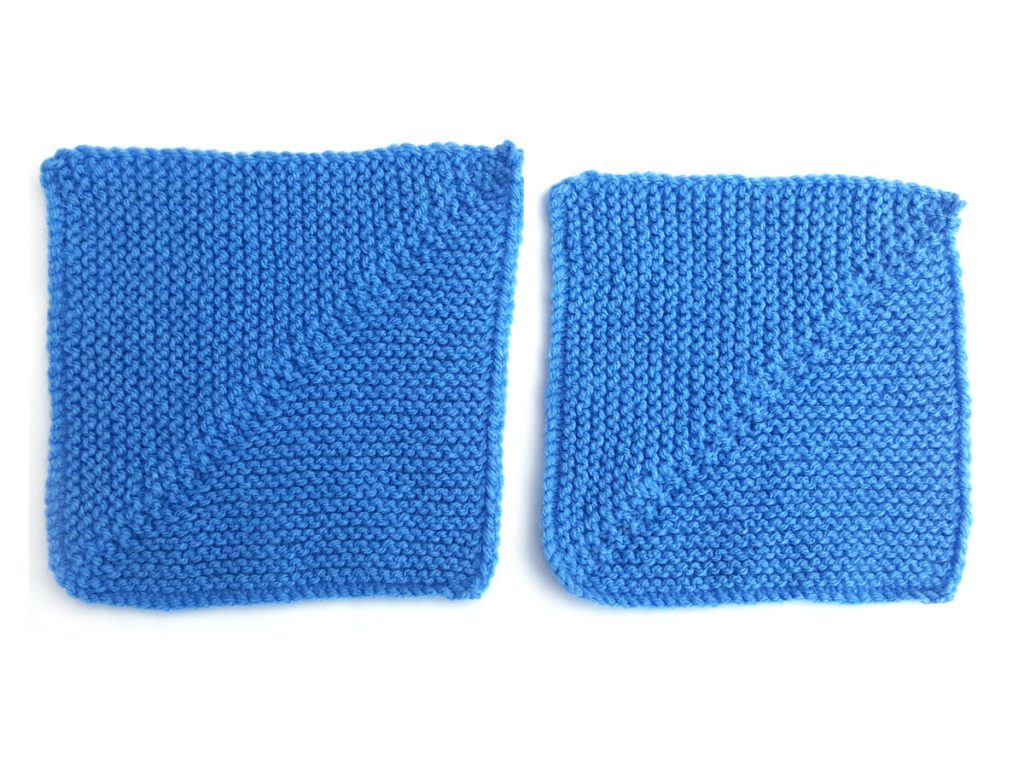
A mitred square is just one way of knitting a corner-to-corner (C2C) square. Usually for the purpose of making a blanket.
But not all squares come out, well, square. Some come out wonky. Or kiteish shaped.
The Three Groups of People
When making a mitred square, following a traditional mitred square pattern, there are 3 groups of people…
Group A makes a perfect square.
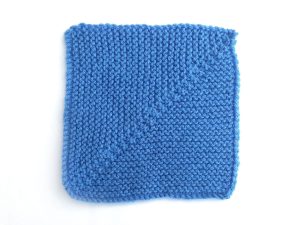
Group B make an elongated wonky kiteish shape. (aka me).
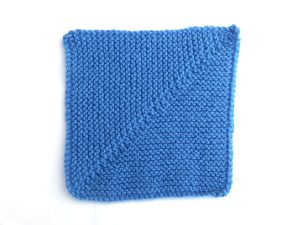
Group C make a squished wonky shape. (I’ve never come across one of these people but logic dictates that they are out there. So I’m including them for completeness – photo squished in Photoshop).
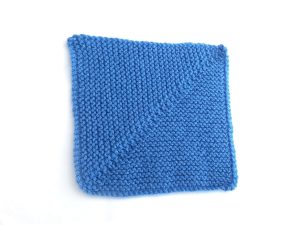
The Myth
One of the general knitting rules myths is that, in garter stitch, you need twice as many rows as stitches to make a square. That means if you cast on 10 sts you need 20 rows to get a perfect square.
This is because your stitches, in garter stitch, are generally accepted to be twice as wide as they are tall. They have a ratio of 2:1. 2 rows = 1 st.
Which by now I hope you understand to not always be true.
We all have our own tension and gauge. We are not all 2:1.
Which Group is Which?
We do not all fit into the “perfect square” box.
The people who do have this 2:1 ratio are Group A. They make a perfect square.
Group B have slightly taller stitches. So they need fewer rows. My personal ratio is 7:4. This means that for every 4 sts I need 7 rows to make a square.
Group C have slightly shorter stitches. So they need more rows. For example, they may have a ratio of 7:3. This means that for every 3 sts they need 7 rows to make a square.
How To Calculate Your Personal Ratio
To work out your own personal ratio, you need to knit a garter stitch square. I recommend casting on a multiple of 4 sts (like 28 or 32) as it’s an easier number to divide later. Cast off when you have a square.
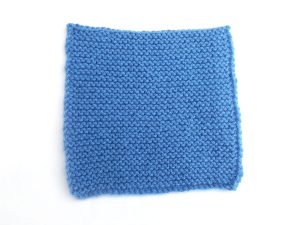
Count the number of rows you knit. A quick way to do this is to count the garter ridges and double it.
Now for the math. (Sorry).
If you cast on 32 sts and have 56 rows (like me) then your starting ratio is 56:32.
Now we just need to reduce the ratio to its lowest form. You need a number that both numbers divide by.
In this case, they both divide by 4.
56 divided by 4 is 14.
32 divided by 4 is 8.
So we get a ratio of 14:8.
This can be lowered even more by 2.
14 divided by 2 is 7.
8 divided by 2 is 4.
So we get a ratio of 7:4.
There isn’t a number that these will both divide into anymore. So the final ratio is 7:4.
Which Group Are You?
Group A will have a ratio where the rows (first number) is exactly double the stitches (second number). Such as 2:1, 4:2, etc.
Group B will have a ratio where the rows (first number) are less than double than the stitches (second number). Such as 7:4, 8:5, etc.
Group C will have a ratio where the rows (first number) are more than double than the stitches (second number). Such as 7:3, 9:4, etc.

Are you overwhelmed by how much you need and want to knit?
Knitting is NOT always relaxing. Knitting can be a source of stress too.
The “Knitting Netherspace” is the primary technique I use every day to help reduce and eliminate stress.
As well as an explanation of what it is, the eight-step checklist included in this eBook will help you reach the realm in your sub-conscious, that I call the Knitting Netherspace, that brings with it new feelings of clarity, calmness, and happiness to your daily life.
How To Use Your Ratio To Make Your Personal Mitred Square
Now you know your ratio, let’s create your personal mitred square pattern. (Sorry, a little bit more math for Groups B and C).
Group A Pattern
You’re lucky and have no further math to do. Woo hoo!
You can use the following pattern, or any standard mitred square pattern, without any alteration:
Cast on half your stitches. Place marker. Cast on the other half of your stitches.
Every Row: Sl1, knit to 2 sts before marker, k2tog, slip marker, knit to end.
Repeat until you have 2 sts left. Cut yarn and bind off remaining 2 sts.
Group B Pattern
We will use the ratio of 7:4 as an example.
When we knit a mitred square we cast on two sides worth of stitches, and reduce it down to 0 stitches. So we simply need to double the number of stitches in our ratio. So 7:4 becomes 7:8. Or 7 rows to 8 stitches.
This means, that for every 7 rows of knitting, we need to decrease 8 stitches to create our perfect square.
So the pattern becomes:
Cast on half your stitches. Place marker. Cast on the other half of your stitches.
Work every row (both right and wrong side) as follows: Sl1, knit to 2 sts before your marker, k2tog, slip marker, knit to end. With the exception of every 7th row (change this to the row number in your ratio) which is as follows: Sl1, knit to 3 sts before your marker, k3tog, slip marker, knit to end.
Repeat until you have 2 sts left. Cut yarn and bind off remaining 2 sts.
Group C Pattern
We will use the ratio of 7:3 as an example.
As with Group B, we simply need to double the number of stitches only in our ratio. So 7:3 becomes 7:6. Or 7 rows to 6 stitches.
This means, that for every 7 rows of knitting, we need to decrease 6 stitches to create our perfect square.
So the pattern becomes:
Cast on half your stitches. Place marker. Cast on the other half of your stitches.
Work every row (both right and wrong side) as follows: Sl1, knit to 2 sts before your marker, k2tog, slip marker, knit to end. With the exception of every 7th row (change this to the row number in your ratio) which is as follows: Sl1, knit to end, slipping the marker as you go.
Repeat until you have 2 sts left. Cut yarn and bind off remaining 2 sts.
And That’s It…
I hope this tutorial will help you go away and create your very own mitred square blankets now.
Let us know what your personal ratio is in the comments. I’d love to know if there really are any Group C people out there!
Best wishes, Sam xox
If you want to receive new articles from us directly into your inbox, then please sign up below.
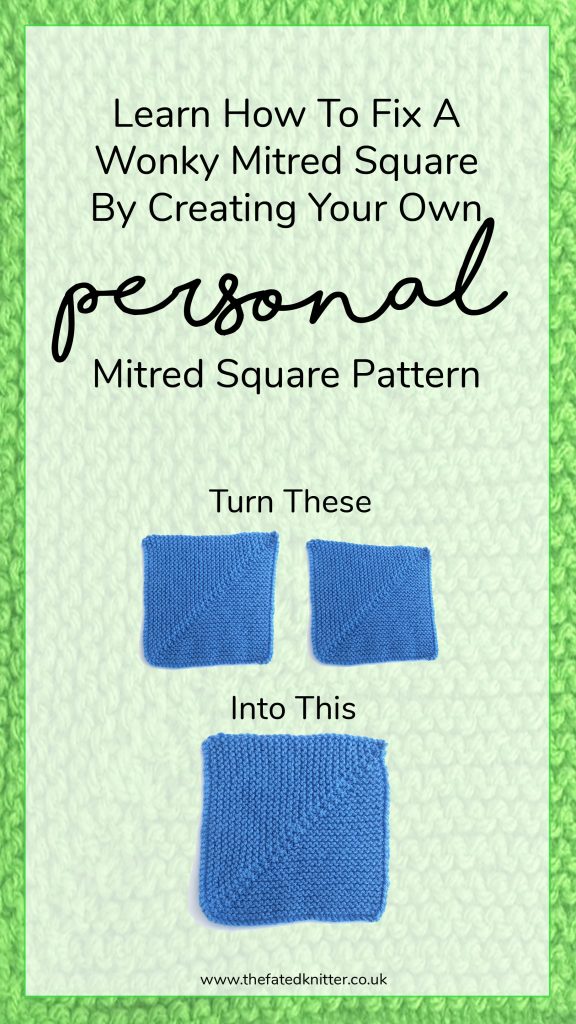
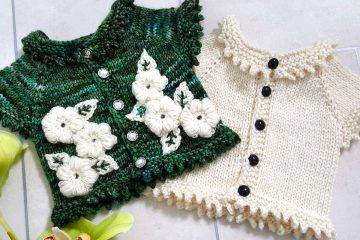

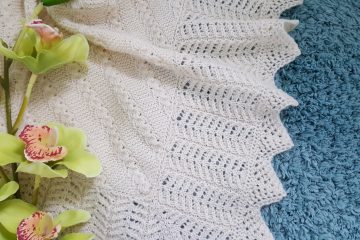
2 Comments
Mary · 22nd July 2023 at 3:47 pm
Hi Sam – I’m a “kite” mitred square knitter so I was excited to find this post of yours! I just tried it this morning. My ratio is 8:5, so that means I need to reduce by 10 sts every 8 rows, if my calculations are correct? I decided to try a small mitred square to see if it would work for me. To reduce by 10 sts every 8 rows, I K3tog on rows 4 and 7 (if I had done 4 and 8, one side would’ve got smaller faster than the other – luckily I realized this before I made the mistake!). What I got…was a reverse kite, aaauuuuggghh! Any tips/thoughts? I would love to make a mitred SQUARE rather than a mitred KITE….
Samantha Main · 27th July 2023 at 8:38 pm
Hi Mary! I’m glad to meet another mitred kite knitter 🙂 The math you’ve come to would be correct. I am wondering if there is a half stitch somewhere causing a complication instead. May I suggest reducing 9 stitches for every 8 rows instead. To ensure an even decrease on both sides, you would need to alternate the k3tog on the 8th row and 7th row. Please let me know if this helps. Best wishes, Sam xox